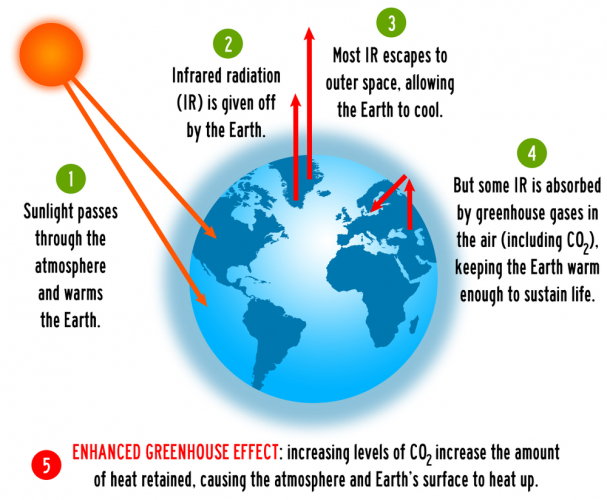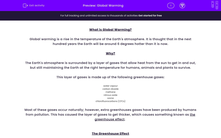Did you know that in the next hundred years the Earth will be around 6 degrees hotter than it is now?
This is due to global warming.
What is Global Warming?
Global warming is a rise in the temperature of the Earth's atmosphere.
Why is the Earth's temperature rising?
The Earth's atmosphere is surrounded by a layer of gases that allow heat from the Sun to get in and out, while still maintaining the Earth at the right temperature for humans, animals and plants to survive.
This layer of gases is made up of the following greenhouse gases:
water vapour
carbon dioxide
methane
nitrous oxide
ozone
chlorofluorocarbons (CFCs)
Most of these gases occur naturally, however, extra greenhouse gases have been produced by humans from pollution. This has caused the layer of gases to get thicker, which causes something known as the greenhouse effect.
The Greenhouse Effect

The diagram above shows the greenhouse effect where the heat from the Sun passes through the atmosphere to heat the Earth's surface.
Normally, many of the Sun's rays would simply bounce off the surface and head back out of the Earth's atmosphere. However, this is now becoming a problem. The layer of greenhouse gases in the atmosphere blocks some of the Sun's rays from getting out, meaning that they are reflected back to Earth to heat the surface once again.
The layer of gas acts like the glass in a greenhouse (hence the name!) - it lets the heat in but does not let it back out.
Where are these extra greenhouse gases coming from?
The burning of 'fossil fuels' produces carbon dioxide, water vapour and nitrous oxide.
We can see from the graph below that the CO2 levels clearly go up and down but, since the Industrial Revolution, they have rocketed to a much higher level than ever before. The green line (at 350 ppm) shows what many scientists think is a safer level of CO2.

The cutting down of trees and rainforests is also increasing the CO2 and water vapour levels as the plants that would absorb them are being destroyed.
Natural animal waste will release methane, and the increasing human population means increased farming, leading to an increase in animals/animal waste.
So what could happen?
If the Earth's temperature continues to rise this could lead to:
Polar ice caps melting causing sea levels to rise
Flooding
Lakes and rivers drying up, killing the aquatic life that once lived there
More droughts making it harder to grow crops
Less water for drinking, cleaning and growing crops
The loss of some plants and animal species due to the heat and dry conditions
Hurricanes, tornadoes and other storms (which are caused by changes in heat and water evaporation) may get more common.
What can we do to help?
The world leaders in the UN have agreed to try to reduce the CO2 levels in the atmosphere by the use of alternative clean fuels such as solar and wind power.
Saving water and energy is a big thing and can be helped by:
Switching off all electrical appliances when they are not being used (don't leave them on standby)
Using energy-saving light bulbs
Washing clothes at 40 degrees or below
and many, many more.
Have a look around your house and see how good you are at energy-saving!
Now we will check out some questions on global warming.








